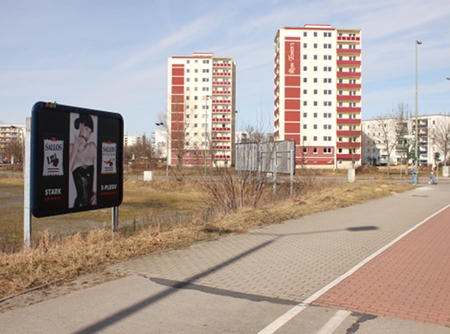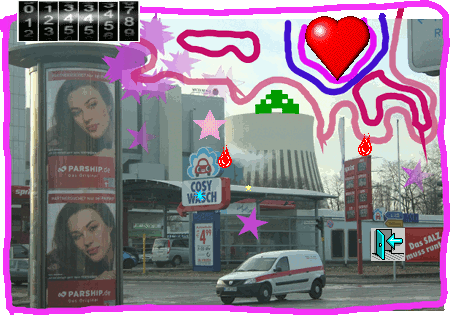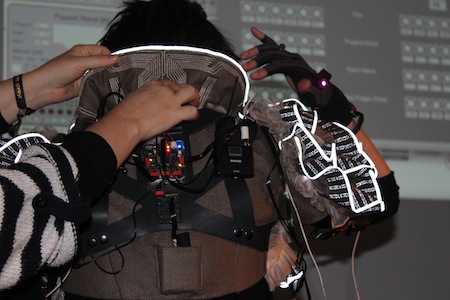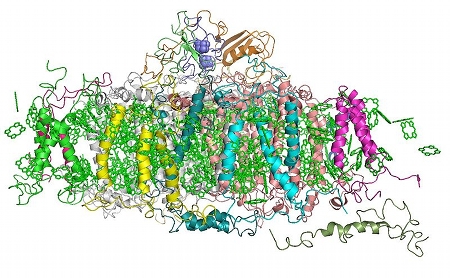Maxwell’s equations of human behaviour
Monday, May 27th, 2013
on the attractivity of locations: refurbished buildings in Marzahn-Hellersdorf, among them the now newly renovated Rhin Towers
I have found Maxwell’s equations of human behaviour!
randformblog on math, physics, art, and design |

on the attractivity of locations: refurbished buildings in Marzahn-Hellersdorf, among them the now newly renovated Rhin Towers
I have found Maxwell’s equations of human behaviour!
A sort of brief follow-up to the last two posts about simulations. Here a link to Tim’s simulation of a critter under the couch.

artwork: “Berlin citysimbim” by glocki
This post is a kind of follow-up post to the last one, which dealt amongst others with simulations of political/economic scenarios in multiplayer online games. In a couple of days a new SimCity game will come out and as Wikipedia puts it:
This version of SimCity will be the first to feature full online play since Maxis’s SimCity 2000 Network Edition,[1] allowing for regions to house multiple cities from different players. Regions can alternatively be set to private for solo play.[31] SimCity will require players to be logged into EA’s Origin service to play the game, including when playing single player.
or as SimCity.com puts it:
SimCity has truly connected cities within larger regions for the first time. Cities do not exist in a bubble – they are living, breathing systems that make up a region – and now you can trade and share resources among cities and regions in real time.
Unfortunately the above mentioned Origin seems to have sofar stirred up a lot of controversy about privacy issues. In Europe there are currently new data protection regulations underway, which by the way seem to be heavily “informed” by lobbyists. (The website Lobbyplag (unfortunately sofar only in german) gives an overview, which law drafts have been directly pasted in from which lobbyists brochures.) In view of this ungoing process it is thus however sofar not clear wether any of the discussed privacy issues of Origin will have any or what juridicial consequences.
SimCity2013 seems to allow for no modding at least right after launch. That is in an interview with gameinformer SimCity lead producer Kip Katsarelis replied to the question:
Is there an element of user-created content and sharing in city customization?
We’re not committing to any of that at this time, but we know that is part of Maxis. In SimCity 4, a lot of those tools were released pretty much a year after launch. So, definitely on our minds, but I can’t promise that we’re delivering on any of that right now.
If modding would have been possible then -apart from eventual privacy/data protection problems- the people from the project of the last post could have eventually thought about wether it would make sense to use SimCity2013Mods for their purpose. However it should also pointed out, that even if modding would be possible then too political game mods could pose problems.
One should also think about the economic consequences of computer simulations/games etc. (you may eventually also want to read my comment on the blog Backreaction in this context.)
addition 13.12.17: For the readers convenience, here a copy of the comment on the blog Backreaction:
nad0815 said…
What you seem to be somewhat discussing is to some extend wether there exist some god(s).
That is if I replace “simulation” with “creation by god” and if I replace “computer” with “human mind accessible universe” then your discussion looks very similar to that discussion.
Finally wether something feels “simulated” or “real” is quite a question of perception. You may eventually want to read:
And since there are quite some humans who claim that they already saw/perceived/DISCOVERED the “simulator(s)” your “coincidence problem” seems to be spread over all centuries.
you wrote:
“To begin with, unless you want to populate the simulation by hand, you need a process in which self-awareness is created out of simpler bits. And to prevent self-aware beings from noting the simulation’s limits, you then need a monitoring program that identifies when the self-aware parts attempt to make an observation and exactly which observation.”
Why should self-awareness (of limitations) be necessary to simulate self-aware entities? In fact a simulation of (aware) entities could happen by un-self-awarely mimicking a construction process and/or by chance. In that case your simulation would neither be a “creation of an aware god” nor be it “fully self-organized by some abstract laws and/or random outer conditions”. And thus there seems to be in particular no reason why simulated entities need to be kept from noticing that they are simulated like in order “to save on computational power” – that is they could awarely simulate without knowing that they are simulated themselves or they could even simulate whatever while being completely unaware of whatever. Both would need calculational power.
In fact I do think that nowadays “simulations” in computer games (and related computer environments) use up a lot of power, labour, time etc. and that this seems to have already quite an economic impact:
http://www.azimuthproject.org/azimuth/show/Economic+growth+and+limitationsSo you’d never observe any effects of finite lattice spacing because whenever you look all symmetries are restored. Wicked. It also creates other scientific problems.
(short side remark: There exist of course also fractals)
Considering the alien question: The reason that we have sofar not detected any “aliens” could of course be also for the reason that mankind has sofar been regarded as a kind of “baby civilization” and has thus sofar been protected from any shocks which could result from meeting the aliens…
5:24 AM, March 03, 2013

Musician Imogen Heap in her tech wear
In a recent comment on randform randform reader Bibi asked:
You had written at Azimuth that your idea to use MMOGs for simulating economic and political real world scenarios
seems to have recently been picked up for the Global Participatory Platform of the 2013 Flagship proposal FucturICT
It seems also that your scientific platform idea had been picked up for that ICTfutur grant proposal.
What about your intellectual property?
The FuturICT application for 1 billion Euros had though been turned down, will you now write an EU grant proposal?
Answers to this comment after the click.
Der deutsche Text in diesem Post ist nach dem Link:
Read the rest of this entry »
As described in the last german TAX post I was trying to get information about german income taxes, in particular I wanted to get the concrete formulas. I asked via fragdenstaat.org at the Federal Agency for Civic Education (Bundeszentrale für politische Bildung: BPB) for that information, since they have a webpage about income taxes. This page however cited only a little phrase, with the names of the different income zones before I wrote the letter, but luckily it got meanwhile at least a little revamped. However the page still doesn’t show the formulas, moreover it is not very up-to-date. In addition the BPB was not only not able to help me with my request, but I was told that:
” In Bezug auf weitere steuerrechtliche Auskünfte bitte ich Sie, von Anfragen bei der bpb Abstand zu nehmen, weil wir definitiv nicht dafür zuständig sind.”
(translation without guarantee: with regard to further tax law requests I ask you to precind from sending further requests to BPB, because we are definitly not in charge for this.)
I should maybe also mention that I asked a representative of the ministry of economics for the formulas, who said I should ask a tax consultant.
As already said in the comment at fragdenstaat.de I had then finally found formulas for the taxes 2010-2012 (after a long search). The formulas are on the site of the ministry for finance with the taxcalculator and you can get the formulas if you type in any income, and then hit the button “BERECHNEN”. I couldnt however find the formulas for the original draft for the taxes for 2013 from February last year, neither the formulas for the new draft as of december 12 last year for the taxes for 2013. Mr. Liebig, who runs the website www.lohn-info.de had however found them and had included the numbers on his site, so I wrote him an email and asked him for the links.
I have meanwhile got an answer from Mr. Liebig who had kindly send me the links via email.
A document which describes the taxes for the upcoming year, as of 121212 is at the website of the Bundesrat.
A document which was the old draft for the 2013 taxes and which was intended to mitigate the impact of higher taxes due to BRACKET CREEP is at
http://dip21.bundestag.de/dip21/btd/17/086/1708683.pdf
I meanwhile included the new numbers into the formulas. Details (in german) and the mathics code can be found after the click.
The result in short: If I didn’t miscalculate then there are tax reductions of 8-24 Euros/year for the incomes above 13500 Euros per year. For incomes of 8100 Euro to 13500 Euros there is a tax increase of about 15 Euros/per year. The procentual bracket creep (not sure wether this is called this way, please look at formulas) is for 6% income increase maximaly about 2.5%, for 2% income increase it is about 0.8%.
Following an article in the Daily Mail, there is currently an interesting discussion at Azimuth about the interpretation of climate data. While the Daily Mail is convinced that global warming stopped 16 years ago as written in the article:
Global warming stopped 16 years ago, reveals Met Office report quietly released… and here is the chart to prove it, the news agency France24 looks at what for example shipping developpers think about the karma of global temperature variations:
Shipping developers eye up route through melting Arctic
However I don’t know how much the depiction* of Walrusses in a russian canteen should indicate how this may change the menu.
*please scroll down to about to the half of the image, next to the word Stoloweia.

image by Curtis Neveu on wikipedia
About five years ago there was on randform a question regarding the possibility to study the electron transport in a pigment-protein complex via some optical methods in the attosecond regime. Understanding this may be important for the development of new types of solar cells. From the randform post:
It would be interesting to know wether such high temporal resolution could also be used for investigating electron tranfer in pigment-protein complexes such as in a
photosynthetic reaction center (see image above)(correction 05.10.2012: in a FMO complex (the reaction center seems to be a part of this complex)), which was done by researchers in Berkeley e.g. in a 3 pulse two-color electronic photon echo experiment with 750 and 800 nm pulses in the femtosecond range (science 316 (5830)) or wether the high energies of the corresponding laser pulses would alter the corresponding structures, which apparently happenes if one shoots with gamma rays on a pigment.
In a press release which reports about measurements at the photosystem 1 (PS 1) protein (which appears to be even more complex than the above mentioned FMO complex) it seems that one can at least measure the speed of charges in a photosystem with the help of optical devices.
Not only the press release but even the article itself:
Photocurrent of a single photosynthetic protein, by Daniel Gerster, Joachim Reichert, Hai Bi, Johannes V. Barth, Simone M. Kaniber, Alexander W. Holleitner, Iris Visoly-Fisher, Shlomi Sergani & Itai Carmeli
is actually still currently available on the nature nanotechnology website.
The results of their research makes the researchers write (see article):
Our results demonstrate that individual PS I units can be integrated and selectively addressed in nanoscale photovoltaic devices while retaining their biomolecular functional properties. They act as light-driven, highly efficient single-molecule electron pumps that can function as current generators in nanoscale electric circuits.
Instead of directly shooting with lasers the researchers were here however “exciting the PS 1 with a “633 nm laser light with a power of ~4 mW “from the back of the tip” (see figure 1 in the article), which I understand as that the laser light went through the glass of the tip of a scanning near-field optical microscope before it entered the PS 1 (the PS 1 was “glued” via cysteine mutation groups to the glass tip). Moreover the light makes electrons travel through the protein (as I understand with the help of a voltage through the protein i.e. between the tip and the ground) and this can be measured as a current:
The photocurrent was measured by means of a gold-covered glass tip employed in a scanning near-field optical microscopy set-up. The photosynthetic proteins are optically excited by a photon flux guided through the tetrahedral tip that at the same time provides the electrical contact.
The researchers sketched out the whole reaction-centre electron transfer chain and showed electron transfer and recombination times (see figure 2). I didn’t understand where the detailled knowledge for this figure came from, however their measurement seems to be in good agreement with this knowledge, they write:
One of the most significant results in our experiment is the intriguingly large value of ~10 pA for Iphoto. This translates into a turnover time of ~16 ns; in other words, every ~16 ns, an electron transverses the PS I covalently bound between the two electrodes.
(remark: with electrodes the researchers mean here probably the tip and the ground)
The wavelength in the experiment was 633 nm laser light with a power of ~4 mW but I have no feeling how the light is altered by the scanning near-field optical microscope. In particular I still don’t know wether one could use the high resolution laser pulses to investigate the traveling electrons within a photo system without destroying the photo systems.
Because in principle it seems one could make interesting films with this, similar to what had been done for topological insulators.
addition 090113:
It seems there are already some applications underway, which use PS1, which seems also to be up for a patent. I can’t read the original article , but there is some english description e.g. on nanowerk. Found via Sascha Peters on Liligreen.
I haven’t written this explicitly, but may be I should. PS1 is interesting not only because it has a high quantum efficiency (here a current record for quantum efficiency in quantum dots) and because it is usually available in ecofriendly materials like spinach but amongst others also because it seems that the charge carrier separation works rather well. The above work seems to be amongst others probably concerned with studying the involved mechanisms of charge carrier separation, i.e. last but not least it is concerned with the mechanisms of electron transfer.
On that issue I had written five years ago: “electron transfer in the photosynthetic reaction center of Rhodobacter sphaeroides in the above experiment seems to be highly efficient due to the long coherence between the exiton states of two chromophores corresponding to the bacteriochlorophyll b (BChl-b) molecules and bacteriophaeophytin b molecules (BPh) of a photosynthetic reaction center.”” (the comment was based on observations of the Fleming group) but I haven’t found the time and means to look into these mechanisms much further.
addition 24072014:
There is a new article in nature concerned with some of the above questions, in which Serial time-resolved crystallography of photosystem II using a femtosecond X-ray laser is used to investigate the catalytic processes in photosystems. I can’t read the article, but only the abstract and look the images, but that is already quite interesting. In particular concerning the above comment about the correlations one sees in image c how the spatial configuration of the molecules in the electron transfer chain looks like. After the photosystem II primary donor P680 one sees achlorophyll Chl_A and then a pheophytin Pheo_A. In the Wikipedia description of P680 it is written:
The primary donor receives excitation energy either by absorbing a photon of suitable frequency (colour) or by excitation energy transfer from other chlorophylls within photosystem II. During excitation, an electron is excited to a higher energy level. This electron is subsequently captured by the primary electron acceptor, a pheophytin molecule located within photosystem II near P680.
This sounds as if Chl_A is rather in charge of the excitation energy transfer to P680 than as part of the electron transfer from P680 to Pheo_A, which seems different from what the little orange arrows in image c indicates. So a question which arises here is wether one can here observe a long coherence between exiton states of Chl_A and Pheo_A (as it seems it exists for the case of BChl-b and BPh) and wether this involves P680 or not. It seems as if the grid like bubbles in the images g,h,i are eventually charge carrier configurations (? that is those seem to be electron density bubbles upon making a survey on the results of googleing what is an omit map). However I can’t even identify Pheo_A in those images.
addition 19092014:
The question about how the concrete energy transport pathway looks like concretely was raised also on the Azimuth forum
addition 04102017:
I detected an article which explains:
Why Quantum Coherence Is Not Important in the Fenna–Matthews–Olsen Complex
The authors, who apparently use certain Hierarchical equations of motion techniques claim:
Our exact results are then compared to calculations using the incoherent Förster theory, and it is found that the time scale of energy transfer is roughly the same, regardless of whether or not coherence is considered. This means that coherence is not likely to improve the efficiency of the transfer. In fact, the incoherent theory often tends to overpredict the rates of energy transfer, suggesting that, in some cases, quantum coherence may actually slow the photosynthetic process.
Remark: There exists now a Förster resonance energy transfer on Wikipedia, but I don’t know in how far this is related to (incoherent) “Förster theory”.
addition 22092022:
Researchers try to find artificial alternatives to the movements of excitons in plants. Here an approach with polaritons.
( B. Liu et al., “Photocurrent generation following long-range propagation of organic exciton-polaritons,” Optica 9, 1029 (2022).)
LIMITED TIME OFFER !!!! LIMITED TIME OFFER!!!!! LIMITED TIME OFFER!!!!
There is now a new subsection Energy demand, economy and virtual values to the section Economic growth and limitations of the article draft: New economic schemes in games at Azimuth, which adresses the different uses of intellectual properties.
Nad wrote: “In addition I proposed to the people at arxiv to introduce a closed pre-preprint section for the arxive for timestamping works (something I am going to talk about later in more detail)”
Why did you write to the arxiv people? You should have made that public!
The recent protests against journals could have started much earlier if all people would have published their ideas earlier!
With “protests” Sheila is probably referring to the current protests against the publisher Elsevier and the increasing discussions (see e.g. the forum math2.0) about different models for scientific publishing and mathematical software.
My answer to this: I actually “made this public” in a comment on the math blog n-category cafe. The search button at the n-category cafe doesnt work to good, so I currently can’t find the comment. It must have been something like in 2009. In this n-category cafe comment I explained that it would be good to establish a “lockable section” at the archive (see below) with review function, so this kind of discussion has been prevalent for a while within the math/physics community. As a major application for such a “lockable section” I had actually the review and guidance of Ph.D. thesis’ in mind (a “pre-preprint section”), rather then, whats currently more discussed, the review of finalized articles. Apart from the n-category cafe comment I explained the concept also in this randform post. It may sometimes take a while for a discussion to grow and gain importance.
The underlying concept for these kind of software solutions and in some sense also for the discussion itself is what I would like to call “the traceability of intellectual properties”. On the Azimuth project wiki I recently tried to explain this concept a bit more. Moreover I transferred the concept also to other intellectual property issues, in particular to patents. This resulted in a proposal for a lockable patent archive.
After the click you may find a copy of the current Azimuth project wiki entry.
Short comment: In the above mentioned randform post the revocation of Germany’s former minister of defense Karl-Theodor zu Guttenberg’s doctoral degree following accusations of plagiarism was mentioned. Despite the revocation of his degree it seems he may still be a rather good law expert (at least thats what I understood from the comments of his coworkers). In addition he seems to be an expert on some internet software related issues . I could imagine that the legal subtleties of such online legal facilities could be an interesting subject for a new Ph.D. thesis, but of course I am not his advisor :)